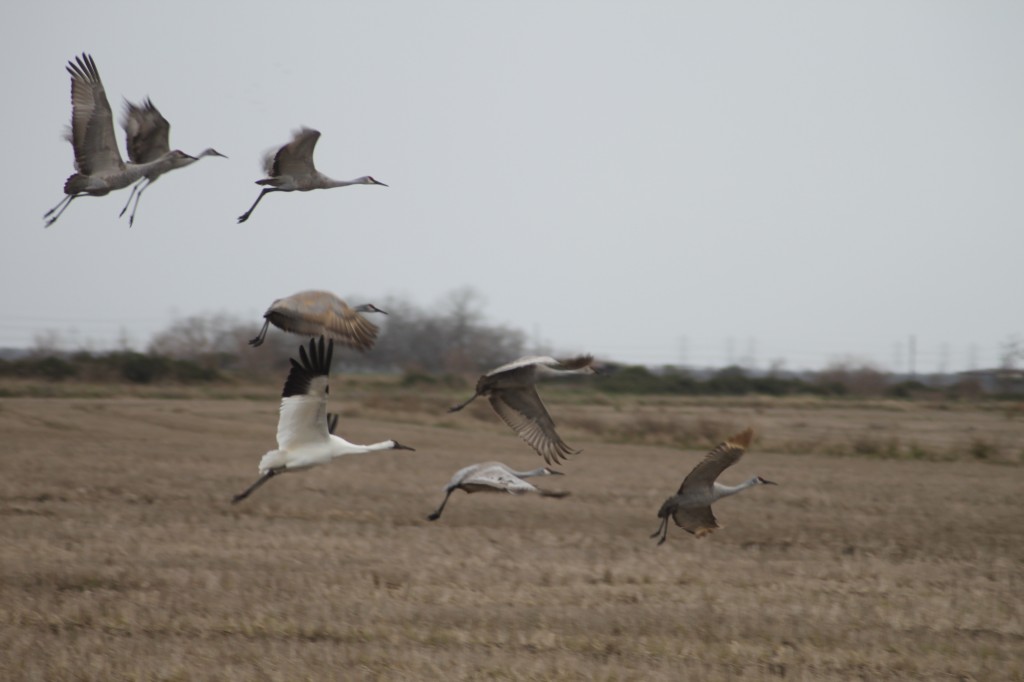By Chester McConnell, WCCA
Aransas National Wildlife Refuge biologists now estimate the population of whooping cranes to be approximately 245 individuals within their survey area. This number does not include whoopers known to be in at least five other Texas counties and other states. Some of the birds are moving around off the refuge for reasons not fully understood. It is believed that the whoopers may be seeking additional food sources. The refuge’s January 2012 survey consisted of three flights conducted on January 26, 27, and 29th. Survey biologists searched Matagorda Island, San Jose Island, Blackjack Peninsula, Lamar Peninsula, Dewberry Island and Welder Flats. A second round of survey flights will take place in mid to late February.
Biologists are receiving many reports of whooping cranes outside the survey area in the following Texas counties: Matagorda, Refugio, Calhoun, Aransas, Williamson, San Patricio, Maverick, and Caldwell. Whooping cranes of the Aransas-Wood Buffalo population are also currently residing in other states as far north as Nebraska. These cranes are naturally supplementing their own food sources by wintering around freshwater lakes and other marshes.
Refuge personnel continue to help alleviate low food resources by doing more prescribed burns. This winter they have burned 8,095 acres of habitat. Whooping cranes have been observed eating the roasted acorns and other food sources in burned areas. An additional 6,129 acres are planned to be burned while whooping crane remain on their winter habitat

- Whooping crane with sandhill cranes in Texas rice field. Photo by Leanne Sliva
Fortunately some rains have fallen of Aransas Refuge recently. The first two weeks of February produced a total of 1.89 inches of rain. Water salinity levels have dropped due to recent freshwater inflows from rain in Central Texas, as well as localized rainfall. Salinity levels in San Antonio Bay are currently recorded as 19.9 parts per thousand. Salinity levels in surrounding bays still remain higher than normal which forces whooping cranes to expend more energy flying to fresh water sources.
Methods of counting whooping cranes on Aransas Refuge have been modified. Refuge official, Vicki Muller explained: “In previous years, the refuge gauged the whooping crane population by counting individual birds within the survey area. The aerial surveys objective was focused on counting every individual bird regardless of where they were located within the survey area. This technique is no longer feasible because the population is increasing. Biologists are flying along a transect, straight lines set at specific distances within the survey area. Previously each survey consisted of a single flight; now one survey includes three flights on three separate days (weather permitting) within a preset timeframe. The birds counted represent an estimate of the population within the surveyed area. It is expected that some birds will be not be included in the count, but this method (known as Distance Sampling) is commonly used to determine rare and endangered wildlife populations, including fin whales, Karner blue butterflies, and raptors.”
Aransas officials explain that, “Over the years the whooping crane population has been growing, the habitat changing, and the birds naturally dispersing. The primary goal is to ensure the recovery of the species and to do that the refuge and its partners must adjust with the ever-changing conditions. In 2009, biologists began putting radio telemetry bands on the cranes. Using leg snares, and other trapping techniques, the birds are captured and equipped with GPS leg bands. This technology records birds locations and allows biologists to learn which habitats they are using, where they stop during their migration, and much more. This technology is extremely valuable but it will be several years before sufficient data from the individual birds can be collected and fully analyzed. It will take a considerable more amount of time before the data will reflect patterns of the population as a whole. To date, the refuge and its partners are tracking approximately 30 whooping cranes with leg bands.”

